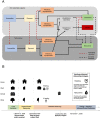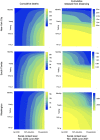This is a preprint.
Modeling serological testing to inform relaxation of social distancing for COVID-19 control
- PMID: 32511519
- PMCID: PMC7273287
- DOI: 10.1101/2020.04.24.20078576
Modeling serological testing to inform relaxation of social distancing for COVID-19 control
Update in
-
Modeling serological testing to inform relaxation of social distancing for COVID-19 control.Nat Commun. 2021 Dec 3;12(1):7063. doi: 10.1038/s41467-021-26774-y. Nat Commun. 2021. PMID: 34862373 Free PMC article.
Abstract
Serological testing remains a passive component of the current public health response to the COVID-19 pandemic. Using a transmission model, we examined how serology can be implemented to allow seropositive individuals to increase levels of social interaction while offsetting transmission risks. We simulated the use of widespread serological testing in three metropolitan areas with different initial outbreak timing and severity characteristics: New York City, South Florida, and Washington Puget Sound. In our model, we use realistic serological assay characteristics, in which tested seropositive individuals partially restore their social contacts and act as immunological 'shields'. Compared to a scenario with no intervention, beginning a mass serological testing program on November 1, 2020 was predicted to avert 15,000 deaths (28% reduction, 95% CrI: 0.4%-30.2%) in New York City, 3,000 (31.1% reduction, 95% CrI: 26.4%-33.3%) in South Florida and 10,000 (60.3% reduction, 95% CrI: 50.2%-60.7%) in Washington State by June 2021. In all three sites, widespread serological testing substantially blunted new waves of transmission. Serological testing has the potential to mitigate the impacts of the COVID-19 pandemic while also allowing a substantial number of individuals to safely return to social interactions and economic activity.
Conflict of interest statement
Competing interests: BAL reports grants and personal fees from Takeda Pharmaceuticals and personal fees from World Health Organization outside the submitted work.
Figures





References
-
- COVID-19 Map [Internet]. Johns Hopkins Coronavirus Resource Center. [cited 2020 Nov 12]. Available from: https://coronavirus.jhu.edu/map.html
-
- Woodward HS Aylin. About 95% of Americans have been ordered to stay at home. This map shows which cities and states are under lockdown. [Internet]. Business Insider. [cited 2020 Apr 16]. Available from: https://www.businessinsider.com/us-map-stay-at-home-orders-lockdowns-2020-3
-
- McFall-Johnsen JK Lauren Frias, Morgan. A third of the global population is on coronavirus lockdown — here’s our constantly updated list of countries and restrictions [Internet]. Business Insider. [cited 2020 Apr 20]. Available from: https://www.businessinsider.com/countries-on-lockdown-coronavirus-italy-...
-
- National coronavirus response: A road map to reopening [Internet]. American Enterprise Institute - AEI. [cited 2020 Apr 14]. Available from: https://www.aei.org/research-products/report/national-coronavirus-respon...
-
- Li Y, Campbell H, Kulkarni D, Harpur A, Nundy M, Wang X, et al. The temporal association of introducing and lifting non-pharmaceutical interventions with the time-varying reproduction number (R) of SARS-CoV-2: a modelling study across 131 countries. The Lancet Infectious Diseases [Internet]. 2020. Oct 22 [cited 2020 Oct 29];0(0). Available from: https://www.thelancet.com/journals/laninf/article/PIIS1473-3099(20)30785... - PMC - PubMed
Publication types
Grants and funding
LinkOut - more resources
Full Text Sources
